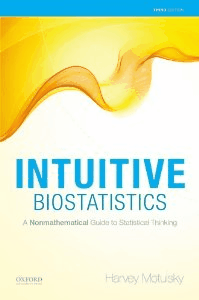|
H.J. Motulsky, Intuitive Biostatistics, ISBN: 978-0199946648, 3rd edition 2014
|
Intuitive Biostatistics is a beautiful book that has much to teach experimental biologists of all stripes. Unlike other statistics texts I have seen, it includes extensive and carefully crafted discussions of the perils of multiple comparisons, warnings about common and avoidable mistakes in data analysis, a review of the assumptions that apply to various tests, an emphasis on confidence intervals rather than P values, explanations as to why the concept of statistical significance is rarely needed in scientific work, and a clear explanation of nonlinear regression (commonly used in labs; rarely explained in statistics books).
In fact, I am so pleased with Intuitive Biostatistics that I decided to make it the reference of choice for my postdoctoral associates and graduate students, all of whom depend on statistics, and most of whom need a closer awareness of precisely why. Motulsky has written thoughtfully, with compelling logic and wit. He teaches by example what one may expect of statistical methods and perhaps just as importantly, what one may not expect of them. He is to be congratulated for this work, which will surely be valuable and perhaps even transformative for many of the scientists who read it.
—Bruce Beutler, 2011 Nobel Laureate, Physiology or Medicine, Director, Center for the Genetics of Host Defense, UT Southwestern Medical Center
If you like the style of this guide, you'll also appreciate the introductory text I wrote: Intuitive Biostatistics.
Overview
Intuitive Biostatistics is both an introduction and review of statistics. Compared to other books, it has:
•Breadth rather than depth. It is a guidebook, not a cookbook.
•Words rather than math. It has few equations.
•Explanations rather than recipes. This book presents few details of statistical methods and only a few tables required to complete the calculations.
Who is it for?
I wrote Intuitive Biostatistics for three audiences:
•Medical (and other) professionals who want to understand the statistical portions of journals they read. These readers don’t need to analyze any data, but need to understand analyses published by others. I’ve tried to explain the big picture, without getting bogged down in too many details.
•Undergraduate and graduate students, post-docs and researchers who will analyze data. This book explains general principles of data analysis, but it won’t teach you how to do statistical calculations or how to use any particular statistical program. It makes a great companion to the more traditional statistics texts and to the documentation of statistical software.
•Scientists who consult with statisticians. Statistics often seems like a foreign language, and this text can serve as a phrase book to bridge the gap between scientists and statisticians. Sprinkled throughout the book are “Lingo” sections that explain statistical terminology, and point out when statistics gives ordinary words very specialized meanings (the source of much confusion).
